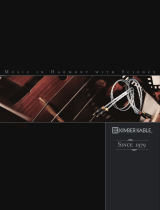Page is loading ...

1/2
PUSH PLATES
USER’S GUIDE
PBJ (Jamb) PBS (Square) PBR (Round)
SIZE (W x H x D)
38 x120 x16 mm 120 x120 x16 mm
152 mm Ø x16 mm
PLAIN FACE PBJ-P PBS- P PBR- P
TEXT ONLY PBJ PBS PBR
TEXT + SYMBOL PBJ-H PBS-H PBR- H
EAS RF (WIRELESS SOLUTION)
Range of radio-controlled receiver and transmitters
Max. contact voltage : 42 V AC
Max. contact current : 0.5 A
Output contacts : dry output contacts (NO, NC, COM)
Front face material : stainless steel with scuff-resistant coating
Temperature range
: from -30° C to +55° C
Typical operating force : 0.45 kg
1 DESCRIPTION
2 ACCESSORIES
3 TECHNICAL SPECIFICATIONS

2/2
1. If the push plate is to be hard-wired to the operator, remove either the knockout on the back or bottom of the box. Then route the
appropriate wire to the box. For a wireless solution, use the EAS RF, our range of radio-controlled receiver and transmitters.
2. Drill pilot holes in plate box as shown in drawing below.
4 holes for square and round box
2 holes for jamb box
3. Drill holes in the wall using the mounting template.
4. Insert appropriate fastener (screw, toggle bolt, etc.) through box and into wall, then tighten box to surface.
5. Finger-tighten the enclosed hex-head screws into the mounting boxes.
6. Place the push plate holes over the hex-head screws. Use the enclosed hex key to fully tighten the screws.
7. Test push plate activation.
EU declaration of conformity
BEA hereby declares that the product PUSH PLATES is in conformity with the basic requirements
and the other relevant provisions of the directive LVD 2006/95/EC.
42.8313 / V2 – 11.14
4 INSTALLATION
Backplate of PBR and PBS
NO
NC
COM
Side View
BEA SA - LIEGE SCIENCE PARK -
A
LLEE DES NOISETIERS
5 -
B-4031 ANGLEUR -
T +32 4 361 65 65 -
F +32 4 361 28 58 - [email protected] -
WWW.BEA.BE
The push plates are constructed with durable stainless steel and painted with scuff-resistant coatings.
To clean the plates, use only a damp, non-abrasive cloth. Regular cleaning with harsh solvents or abrasive materials may cause
deterioration of the paint coatin
g
. Please make the end-user aware of this procedure.
/
